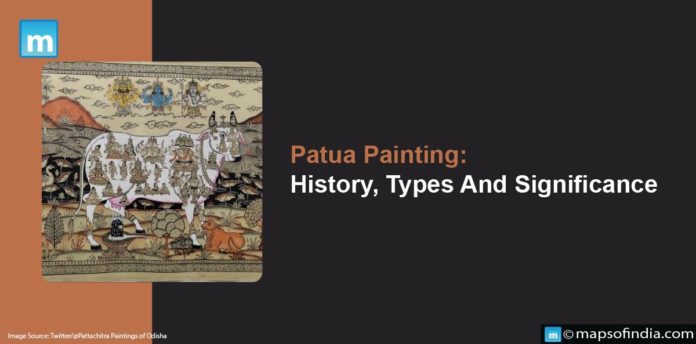Patua painting is a traditional folk art form from India’s state of West Bengal. It is also practised in Bihar, Jharkhand, Odisha, and parts of Bangladesh. Patua paintings are primarily created on fabric scrolls, which are subsequently utilised by itinerant storytellers to convey stories from Hindu mythology, folklore, and current events.
History
The Patuas are a hereditary artist society that has been practising this art style for centuries. They get their name from the Bengali word “pota,” which means “scroll.” The Patuas are thought to have descended from the Brahmin caste but were later shunned because of their affinity with folk art and music. The Patuas are now a Muslim community, but they still paint Hindu deities and legends.
Traditional Patua Painting
Traditional Patua paintings are distinguished by their vibrant colours, clean lines, and dynamic compositions. The painters produce their paintings with natural hues like turmeric, indigo, and red ochre. The scrolls are often painted on coarse cotton cloth, then reinforced on the back with fabric from ancient saris.
Patua paintings frequently depict Hindu deities and mythical stories. The Patuas, on the other hand, paint on various subjects, including animals, plants, and sceneries from everyday life. Some Patua paintings depict current events or social topics as well.
Types of Patua Painting
Patua artwork is classified into two types:
- Scroll paintings: These are traditional Patua paintings used to tell stories. Scroll paintings are often long and narrow, reaching lengths of several feet.
- Panel paintings: These are smaller, more individual paintings that are usually hung or framed. Panel paintings can show various subjects, including deities, animals, and ordinary scenes.
Patua Painting Styles
There are a variety of Patua painting styles, each with unique characteristics. Some of the most common Patua painting styles include:
- Kalighat style: Its bold colours and simple lines characterize this style. Kalighat paintings often depict Hindu deities and mythological stories.
- Midnapore style: This style is characterised by its more detailed and realistic figures. Midnapore paintings often depict scenes from everyday life and current events.
- Birbhum style: This style is characterised by its bright colours and geometric patterns. Birbhum paintings often depict animals and plants.
Cultural Significance
Patua painting is a significant cultural art form for several reasons:
- It is a deeply rooted tradition passed down from generation to generation for centuries.
- It is a unique and expressive form of folk art that reflects the cultural values and beliefs of the Patua community.
- It is a versatile art form that can tell stories, teach lessons, and raise awareness about social issues.
Patua Painting and Its Contemporary Relevance
Patua painting is a vivid and dynamic art genre that is still very much alive today. The Patuas continue to paint on various classic and contemporary subjects, and their work is appreciated worldwide. In addition to being a valuable cultural asset, it plays a vital role in contemporary culture. Patua artists frequently utilise their work to raise social awareness and encourage social change. Some Patua artists, for example, have made paintings highlighting themes such as gender equality, climate change, and poverty.




